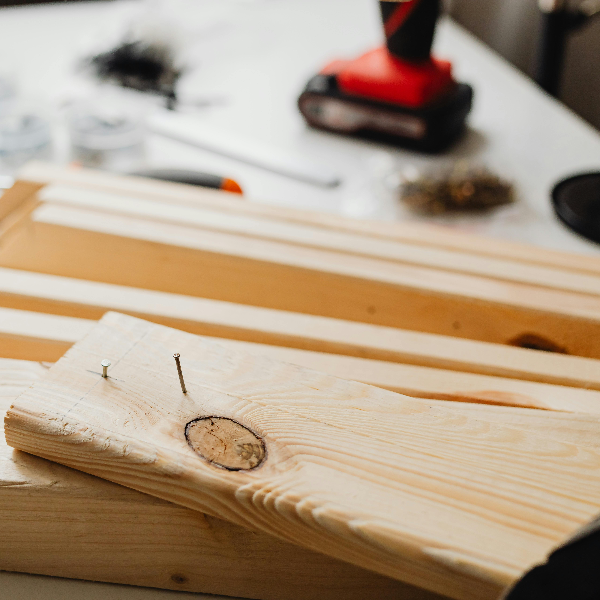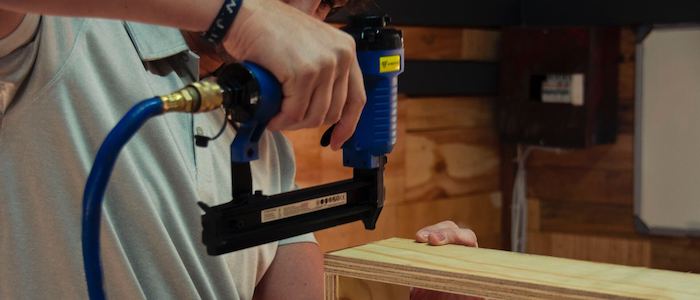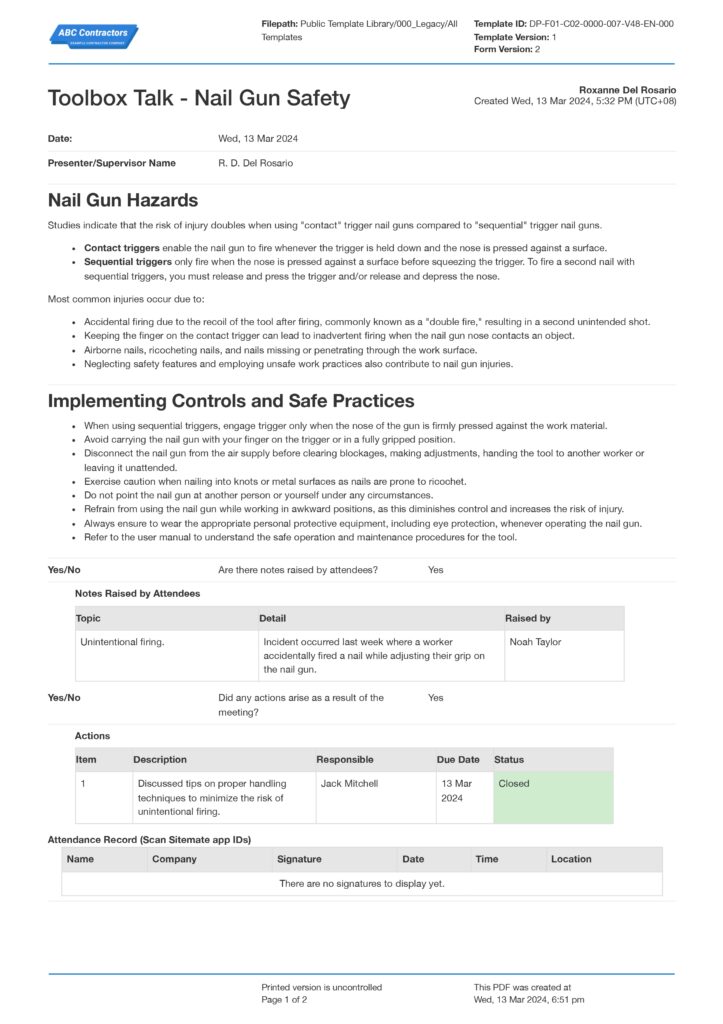Dashpivot Article – Nail Gun Safety OSHA
Nail Gun Safety OSHA
In this article, we will learn about the safety steps OSHA has recommended when using a nail gun, as well as providing other helpful nail gun safety tips and free resources.

Dangers of Nail Guns
Nail guns are modern power tools that are simple to use and also boost the productivity of nailing activities in construction work. Despite their usefulness, nail guns are hazardous and have caused several injuries in the construction industry.
According to the Occupational Safety and Health Administration (OSHA), nail guns are responsible for an estimated 37,000 emergency room visits each year. Furthermore, the National Institute of Health (NIH) conducted a study on nail gun injuries in construction work and found that in residential carpentry, nail gun injuries account for 14% of injuries, with more than half of these involving penetrating injuries to the hand or fingers.
There are many dangers and risks associated with nail guns. The Occupational Safety and Health Administration (OSHA) has made regulations for the purpose of providing companies and contractors with the necessary requirements on nail gun safety and operational measures on the actions they should take to avoid nail gun accidents in their construction task activities.
OSHA Requirements on Nail Gun Safety?
This section will give you the OSHA regulations on nail gun safety. These standards have been derived from the Occupational Safety and Health Administration's 29 CFR 1926, Standards in the Construction Industry, Subpart E: Personal Protective and Life Saving Equipment, and Subpart I: Tools— Hand and Power.
Here are the related standards for nail gun safety:
Head protection 1926.100
This OSHA regulation pertains to the requirements of the head protection required when operating power tools like nail guns. OSHA mandates that employers whose employees work in areas where there is a possible danger of head injury from impact, or from falling or flying objects, or from electrical shock and burns, shall be protected by protective helmets. OSHA provided the standard for helmets that meet the specifications contained in any of the following consensus standards:
- American National Standards Institute (ANSI) Z89.1-2009, "American National Standard for Industrial Head Protection
- American National Standards Institute (ANSI) Z89.1-2003, "American National Standard for Industrial Head Protection
- American National Standards Institute (ANSI) Z89.1-1997, "American National Standard for Personnel Protection-Protective Headwear for Industrial Workers-Requirements
Hearing Protection 1926.101
Any noise that reaches 85 dBA and above is dangerous for a human being. Long and repetitive exposure to such noise levels can cause permanent impairment of hearing. The sound level from pneumatic nail guns averages 94.5 dBA, and peak levels of noise emission for several nailers can range from 109 to 136 dBA.
Since the sound levels produced by nail guns are already unsafe, OSHA requires employers to have workers who operate the power tool be provided with the appropriate hearing protection, and a hearing conservation program must be established. The hearing conservation program must be in accordance with 1926.52 Occupational Health and Environmental Controls, Table D-2— Permissible Noise Exposures. Finally, competent persons must fit or determine each hearing protection device individually.
Eye and Face Protection 1926.102
When a nail penetrates the material during nail gun activities, sharp debris may fly. To prevent any injuries to the eyes and face, OSHA requires employers to ensure that each affected employee uses appropriate eye or face protection when exposed to eye or face hazards from flying particles. The eye protection provided should also equip side protection to maximize shielding the eyes and face from the flying objects. It is permitted to use detachable side protectors that satisfy the relevant specifications of this section, such as clip-on or slide-on side shields. For personnel with eye prescriptions, the employers should incorporate the prescription into its design or wear eye protection that can be worn over the prescription lenses without disturbing the proper position of the prescription lenses or the protective lenses. OSHA has also provided the minimum requirements for protectors, which are
- They shall provide adequate protection against the particular hazards for which they are designed.
- They shall be reasonably comfortable when worn under the designated conditions.
- They shall fit snugly, and they shall not unduly interfere with the movements of the wearer.
- They shall be durable.
- They will be easily cleaned.
The criteria for protective eye and face protection devices must comply with any of the following consensus standards:
- ANSI/ISEA Z87.1-2010, Occupational and Educational Personal Eye and Face Protection Devices
- ANSI Z87.1-2003, Occupational and Educational Personal Eye and Face Protection Devices
- ANSI Z87.1-1989 (R-1998), Practice for Occupational and Educational Eye and Face Protection
Power-operated hand tools 19262.302
There are 2 common types of nail guns, which are electrically powered and pneumatically powered. These types of operations fall under the provision of OSHA’s power-operated hand tools. Provisions on electrically powered tools state that nail guns shall either be of the approved double-insulated type or grounded. It also prohibits establishments from using electric cords for hoisting or lowering tools. For pneumatic-powered nail guns, the hose or whip must be secured by some positive means to prevent the tool from becoming accidentally disconnected. Furthermore, safety clips or retainers shall be securely installed and maintained on pneumatic impact (percussion) tools to prevent attachments from being accidentally expelled.
Another important matter is that all pneumatically driven nailers, staplers, and other similar equipment provided with automatic fastener feed, which operate at more than 100 p.s.i. pressure at the tool, shall have a safety device on the muzzle to prevent the tool from ejecting fasteners unless the muzzle is in contact with the work surface. Never exceed the manufacturer's safe operating pressure for attachments like hoses, pipes, valves, filters, and other fittings. All hoses exceeding 1⁄2-inch inside diameter shall have a safety device at the source of supply or branch line to reduce pressure in case of hose failure. The use of hoses for hoisting or lowering tools shall not be permitted.
Nail Gun Safety OSHA Safety Talk Best Practice

Use this free Nail Gun Safety OSHA Toolbox Talk format for free
Awareness of OSHA Requirements for Nail Gun Safety
Having knowledge about the regulations related to nail gun safety does not only help companies to be fully compliant with the regulatory bodies, but it also ensures the safety of the operations and activities when using nail guns. Educating every employee on these standards also teaches them about the proper safety measures and steps to prevent any mishaps or accidents from happening when using these power tools.
Establishments can make use of toolbox talks to accomplish this objective. Toolbox talks are the perfect avenue to learn such regulations since it is a meeting where information can be easily exchanged from both the presider and the listener due to its informal nature. Furthermore, these meetings allow for the raising of safety-related concerns and issues, which, when addressed, can enhance processes and procedures. Incorporating a toolbox form is crucial for conducting a successful talk. The form must lay out all the topics for discussion and include fields for participants to raise concerns. They will help the presider discuss the topic and allow him to encode any concerns raised during the meeting. These forms will help companies identify areas for improvement and provide proof to auditors that they are following safety regulations and protocols.
Nail Gun Safety Measures
All-inclusive Training Courses
Training helps employees learn the required skills and knowledge when handling power tools, such as nail guns. These trainings could help employees establish a safe work method statement for nail gun procedures. The method statement will already contain the correct procedures as well as the measures needed to be used and placed during the activity. Learning about these will surely ensure that the activity goes smoothly without any possible hazards harming the employees.
Frequent Safety Audits
Conducting audits is one way to determine the proper establishment of regulations, official procedures, and practices. An audit is an on-site verification activity that involves inspecting or examining a process or quality system to make sure that it complies with standards. An audit may focus on a function, process, or production step, or it may apply to the whole company. Frequent audits can also help check gaps and provide solutions on these findings to better improve processes and procedures.
Regular Nail Gun Maintenance and Inspection
Safe operations of nail guns will only be possible if the equipment itself is in excellent working condition. You should never use defective nail guns for nailing activities, as they could pose numerous hazards. To maintain a nail gun, personnel should conduct a routine power tool inspection. This is a proactive approach to keeping the tool healthy to perform its vital function at work. This also helps detect minor problems that could later escalate to bigger problems that affect the functionality and safety of the tool.
Utilizing Signage and Visual Aids
Visual aids and signage will be helpful in reminding the employees of the dos and don’ts when operating the nail gun. Establishments could employ a poster on the required PPE when operating a nail gun. These posters will spark retention in the workers on what PPE they need to wear when performing nailing activities, helping to maintain a safe working area.

Safe Work Method Statement for Power Tools
Power tools pose a constant hazard and risk to many workers. Ensure everyone is using and managing power tools properly with a good SWMS.

Job Hazard Analysis for Carpentry
Keep carpentry work safe from hazards and risks with the Job Hazard Analysis for Carpentry template.

Job Hazard Analysis Roofing
Create safe work processes by using this free JHA Roofing template for your next Roofing project.

